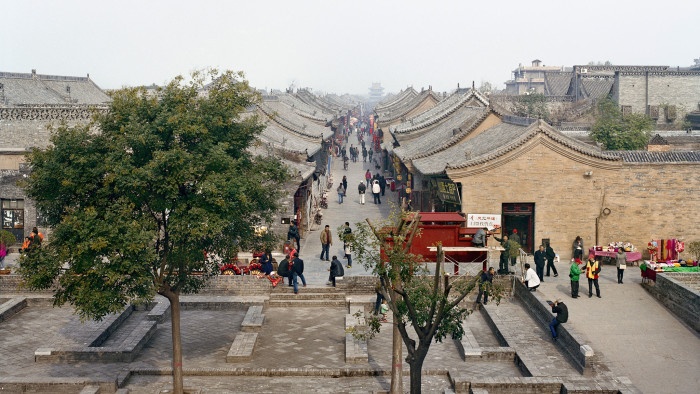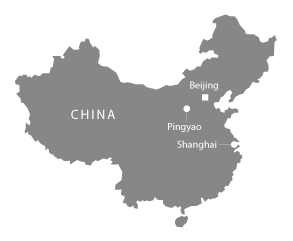Pingyao: the great Wall Street of China

Simply sign up to the Life & Arts myFT Digest -- delivered directly to your inbox.
China’s modern banking industry was born nearly 200 years ago in a small town in the middle of nowhere, a place where today ordinary people still live in the midst of extraordinary architectural splendour. Other Chinese cities have been more than happy to bury their history under skyscrapers but Pingyao, the original Chinese Wall Street and perhaps the best-preserved ancient city in China, chose not to.
No one quite knows why: maybe it was just too poor after the Pingyao banks went bust in the early 20th century along with the Qing dynasty that they bankrolled. Maybe – stranded more than 350 miles southwest of Beijing – it was too remote or just too unimportant to pave with parking lots. Yet now it is places such as Pingyao that are helping China rediscover the value of preserving what little is left of the country’s ancient buildings – not least because there is so much money to be made from them.
For decades China despised the old and idolised the new but when countries get rich, their citizens always wax nostalgic. Pingyao, which was declared a Unesco world heritage site in 1997, is a perfect vehicle for the burgeoning middle class’s new-found love of the past. The city was founded in the 14th century and has hundreds of Ming and Qing dynasty courtyards where people live much as they did in the time of emperors. Ask middle-aged residents how the city has changed since their childhoods and they often say “not much”: ask the same question in any other city in China and residents may struggle to point out anything that remains the same.
Travel agents happily promote Pingyao’s 6km of intact city wall, 12m tall and wide enough to take a horse and cart. But no dry statistic can capture what is really so special about the place – the fact that history is still alive in it. A young girl does her homework atop a stone wall in a courtyard virtually unchanged since China was feudal; a middle-aged man shows off the upstairs room where the maidens of his family, their feet bound, lived before marriage in a kind of Chinese purdah; the nonagenarian woman who sleeps on the same brick kang – a bed heated from inside by coal – that she has used for 50 years in the same Qing dynasty courtyard where she was married decades ago.
Asia has fewer than 10 intact ancient cities like Pingyao, according to the US-based Global Heritage Fund, which is helping to preserve life in the ancient city. China, perhaps the oldest continuous civilisation on earth, once had thousands of such cities. But only a handful remain and even those with a claim to architectural longevity – such as Lijiang in China’s far west Yunnan province – have been over-restored and over-commercialised to the point where they are more theme park than cultural relic.
Many other cities have sought to make money from their history not by preserving it but by tearing down the original fabric and replacing it. “There is a push to recreate fake historic architecture in China,” says Ben Wood, architect of Shanghai’s Xintiandi, a vast shopping and dining area which is perhaps the best-known historic redevelopment in China. “It’s like DisneyWorld,” he says.
But historic preservation experts say that China’s attitude to ancient architecture is not merely a case of greed colliding with pragmatism. Tearing down old buildings has a long pedigree in the middle kingdom: “China is different from Europe in terms of the way it looks at old buildings,” says Ruan Yisan, a professor of urban planning at Shanghai’s Tongji University and a consultant on the preservation of Pingyao. “Throughout history, whenever a new dynasty replaced an old one, everything built by the former dynasty would be destroyed and replaced by new buildings.”

But now all that is changing, says Wood. “They used to just pick the most iconic building [and preserve that] but now they realise the urban fabric also has historic value. They have moved to a more sophisticated assessment of historic artefacts.” Today’s cities are realising that profit lurks in those filthy, crumbling old structures – and in the living culture that exists within them.
Pingyao certainly thinks so. Wei Mingxi is the city’s Communist party secretary and probably the most powerful man in town – and his business cards bear the Unesco logo rather than that of the Communist party, showing how seriously he takes historic preservation. Pingyao’s motto is “to renew and beautify” but, says Wei, “That does not mean tearing down old things and building up new things, it means preserving the ancient city with a new creativity.”
To do that will take money. Wei is not quite sure how much but he says that it will be in excess of the Rmb10bn (£975m) figure cited in the Chinese press. So Pingyao is looking for investors, donors – and even bank loans – to preserve this precious forerunner of the modern Chinese financial system. The city government’s newest project is a subsidy programme whereby it pays half the renovation costs for particularly fine courtyard homes – it estimates that 400 out of nearly 4,000 courtyards in the city are worth preserving. The goal is to keep people living in them, not see them gentrified into boutique hotels.
….
Money has always been the raison d’être of Pingyao: it first rose to fame as a trading centre on the route along which the teas and silks of southern China were transported to Russia and beyond. But carting crates full of silver to pay for all that tea and silk was hard work: eventually one of the city’s merchants thought up a virtual payment system using pieces of paper known as “drafts”.
Thus was born in 1823 the Sunrise Prosperity draft bank – Rishengchang in Mandarin. Its first branch was built on the main street of Pingyao, where it is preserved today, right down to the counting rooms, the silver vaults – and the opium dens where VIP clients were entertained. At the height of its prosperity, Pingyao boasted 22 such “draft banks” or piaohao, with branches all over the country and even overseas. If China seems nouveau riche today, imagine the opulence of a city filled with so many bankers.
The 1.5 million tourists who visit Pingyao each year, most of them mainland Chinese, can see the physical evidence of a simpler global financial system. They can also contemplate a banking industry built on trust (rather than collateral): for many of its earliest years, Rishengchang bank drafts would only be honoured if handwritten by the manager of the Pingyao head office himself. Every Rishengchang manager in the country needed to be able to spot a forgery. Today, the Communist party may have declared war on corruption but the Chinese media have accused the Pingyao local government of using a large part of the town’s tourism receipts to pay for lavish dinners for government officials.
The employment practices of the 19th-century Pingyao banks were less appealing. Staff loyalty was guaranteed by keeping apprentice clerks virtual prisoners for the first three years of their training (they could only visit home if a parent died and were banned from marrying). The banks stashed silver in a brick well built under a kang in a manager’s office and several clerks sat or slept on it at all times. The customer relations officer, however, arguably had a better job: as well as playing mahjong with special clients, he was also expected to smoke opium with them.
Most of the tourists who visit Pingyao this year will stop at the original Rishengchang bank. Many won’t see much more than the old piaohao offices, perhaps the Confucius temple, the city wall – and the curio shops, restaurants and bars that have grown up around them. They will arrive around 10am by the busload, spend a few hours chasing a tour guide’s flag, and depart before sunset. Ji Taiping, head of the city’s urban planning department, calls it “fast food” tourism. Some may also brave a lightning tour of the city’s neighbourhoods, clinging to a golf cart careering through the streets, blaring out pop music. But most will not stop at number 3, Fanjiajie, the courtyard home of 38-year-old Xu Zhouyu and his family.
…
Number 3 is like Pingyao itself: a place where China’s past tries not to clash with its future. Yet pride of place in the late Qing dynasty courtyard is given to a satellite dish – right next to the coal stove that heats the water. Xu has made some minor improvements to the home, which he rents for a fraction of the cost of equivalent accommodation outside the city walls. But he is none too keen on government plans to upgrade his pit latrine to a flush toilet. “Ours is perfectly fine, it’s clean, it doesn’t smell, you can go look at it,” he insists, explaining that a flush loo would cost him more than Rmb1,000 (£98) a year.
Outside in the lane, the cart that empties pit latrines like his rumbles by: privies are still the most common form of convenience in the ancient courtyards. But Xu loves the old place: “It’s very cool inside, I don’t need to pay for air conditioning,” he says as he shows off the Qing dynasty wallpaper in his sitting room. The temperature must be at least 10C lower than the near 40C outdoors.
Down the street, next to number 11, is an unnumbered lane clogged with the kind of illegal structures – shanty kitchens and lean-to loos – that used to be ubiquitous in Pingyao. Soon these extensions will be removed, says an urban planning official. He adds that the old city’s population is being reduced from 60,000 to about 15,000 by moving people to new developments, making it possible for families to live comfortably within the original courtyards.
“The challenge of Pingyao is the challenge of authenticity,” believes Vince Michael, executive director of the Global Heritage Fund. “One of the ways you can distinguish between Disneyland authenticity and real authenticity is that the real stuff sometimes is stinky or ugly or unkempt or unresolved. Like reality.” And like many of Pingyao’s loveliest courtyards.
Nancy Shao, an adviser to the local government from Tongji University’s urban planning department, insists it is not too late to save Pingyao from over-restoration. “But it’s very important to maintain a balance between heritage conservation and local development because if we just focus on heritage protection then local people will not accept it. Our challenge will be to develop tourism in a more sustainable way,” she says, adding, “We have to figure out how to develop high-value-added tourism: the quality is more important than the quantity.”
But Wei, the party secretary – whose success in Pingyao will be judged more by short-term results than posterity – seems little concerned with the risk of tourist hordes engulfing his fragile city. “The more tourists, the better,” he says. Visitor numbers, which could swell with the opening of a high-speed rail link from Xi’an, home of the terracotta warriors, are just “a management problem”. Lovers of ancient cities might be advised to fit in a quick trip to “the country ancestor of China’s financial industry” before he has time to test that hypothesis.
Patti Waldmeir is the FT’s Shanghai correspondent. Additional reporting by Zhang Yan.
Jacqueline Hassink is an award-winning visual artist and was shortlisted for the Prix Pictet 2012.
To comment on this article please post below, or email magazineletters@ft.com
Comments